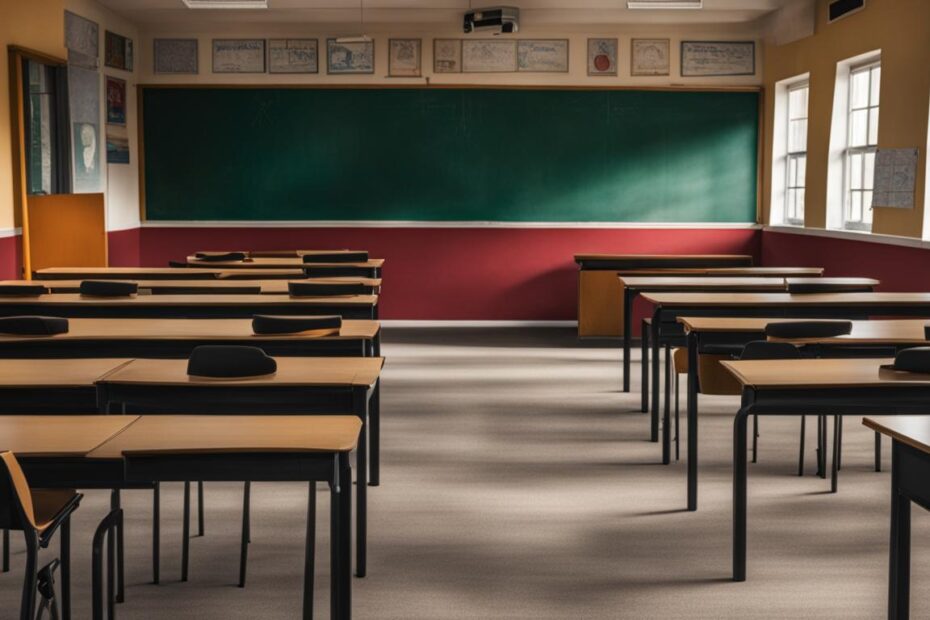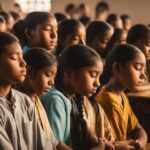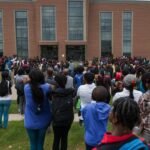As our society becomes increasingly diverse, the question of whether schools should have prayer rooms has sparked a heated debate. Advocates argue that providing prayer spaces in educational settings promotes religious accommodation, religious diversity, and inclusivity. On the other hand, critics raise concerns about promoting religious expression in schools and potential conflicts with the separation of church and state.
In this article, we delve into the pros and cons of incorporating prayer rooms in schools, examine the benefits of prayer in education, and explore strategies for creating inclusive school environments. We also discuss constitutional rights surrounding prayer in schools and address the ongoing controversies and conflicts that surround religion in educational settings. Finally, we highlight the importance of open discussions and education in shaping students’ perspectives on prayer in schools.
Key Takeaways:
- Providing prayer rooms in schools promotes religious accommodation, religious diversity, and inclusivity.
- Benefits of prayer in education include emotional support, a sense of community, and spiritual growth.
- Addressing religious diversity in schools involves creating inclusive environments and promoting tolerance.
- Open discussions and education play a crucial role in fostering understanding and shaping perspectives.
- Examples of accommodating religious diversity include creating religious diversity clubs and organizing multicultural events.
Teenagers’ Views on Prayer in Public Schools
Understanding the diverse perspectives of teenagers on prayer in public schools is crucial in fostering dialogue and promoting understanding among students with different beliefs. To gain insights into this topic, a survey was conducted among high school students, capturing the range of opinions and factors that shape their views.
“I believe that prayer should be allowed in schools as it provides a sense of comfort and support for those who practice religion. It can also promote a more inclusive and understanding school environment.” – Jessica, 16
The survey results revealed a diversity of views regarding prayer in public schools. While some students expressed support for incorporating prayer rooms, citing emotional and spiritual benefits, others voiced concerns about potential conflicts and the need for strict separation of church and state. The opinions varied based on religious background, personal experiences, and exposure to different perspectives on the matter.
- 89% of students believed that prayer spaces can contribute to a more inclusive school environment.
- 56% of students expressed concerns about potential conflicts arising from the presence of prayer rooms.
- 78% of students agreed that promoting dialogue and understanding among students with diverse beliefs was essential.
These findings highlight the importance of creating safe spaces for open discussions about prayer in schools. By fostering respectful dialogue and understanding, schools can create an environment that respects the opinions and beliefs of all students, ensuring an inclusive educational experience.
| Support for Prayer Rooms | Concerns about Conflicts | |
|---|---|---|
| Christian Students | 76% | 32% |
| Muslim Students | 92% | 67% |
| Atheist Students | 42% | 89% |
Benefits of Prayer in Education
Prayer in education offers numerous benefits that contribute to the overall well-being and growth of students. By providing emotional support, fostering a sense of community, and promoting spiritual growth, prayer can play a crucial role in creating a positive and inclusive educational environment.
“Prayer allows students to find solace and comfort in times of stress or uncertainty,” says Dr. Sarah Thompson, a renowned educational psychologist.
“It serves as a powerful tool for emotional regulation, helping students cope with academic pressures and personal challenges.”
Through prayer, students can find strength and guidance, leading to improved mental health and overall well-being.
Prayer also fosters a sense of community among students, bringing them together through shared beliefs and values. It promotes a supportive and caring environment where students can connect and empathize with one another. This sense of community helps to combat feelings of isolation and promotes a positive school culture based on unity and respect.
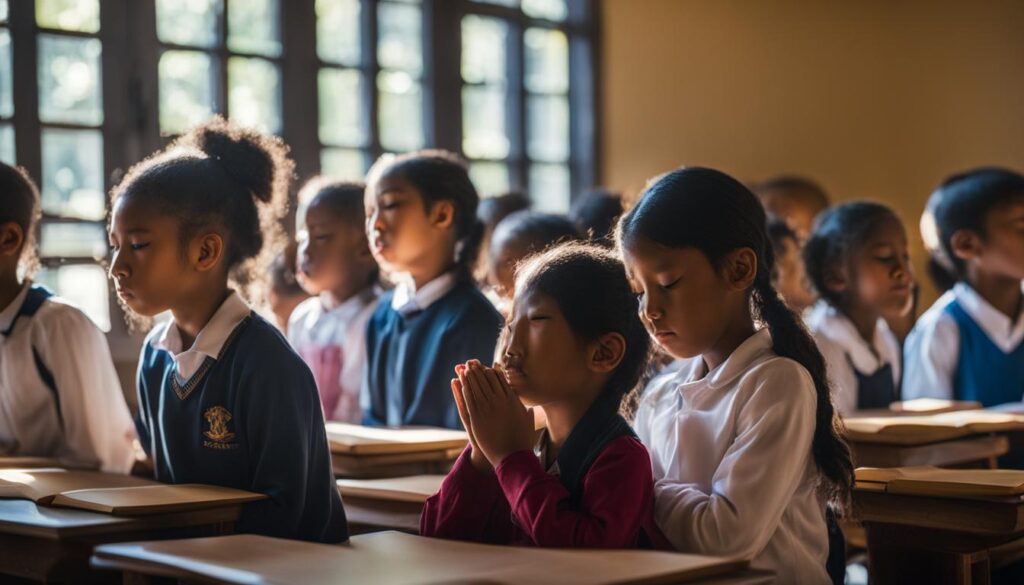
Fostering spiritual growth and promoting resilience
Furthermore, prayer plays a vital role in fostering students’ spiritual growth. It provides them with a sense of purpose and helps them develop a deeper understanding of their beliefs and values. By engaging in prayer, students can explore their spiritual identity, leading to personal growth and a greater sense of meaning in their lives.
Studies have also shown that prayer promotes resilience among students. It equips them with the inner strength and resilience needed to navigate challenges and setbacks. Through prayer, students develop a sense of hope and optimism, enabling them to overcome obstacles and persevere in their academic and personal endeavors.
The Power of Prayer in Education
While the benefits of prayer in education are evident, it is crucial to recognize and respect the diversity of beliefs within the student body. Schools should aim to provide prayer spaces that are inclusive and accommodating to students of all faiths and backgrounds.
| Benefits of Prayer in Education | Description |
|---|---|
| Emotional Support | Prayer provides solace and comfort, helping students cope with academic pressures and personal challenges. |
| Sense of Community | Prayer brings students together, fostering a supportive and caring environment that promotes unity and respect. |
| Spiritual Growth | Engaging in prayer allows students to explore their spiritual identity and develop a deeper understanding of their beliefs and values. |
| Promoting Resilience | Prayer equips students with the inner strength and resilience needed to navigate challenges and persevere in their academic and personal endeavors. |
By recognizing the benefits of prayer in education and ensuring its inclusion is respectful and inclusive, schools can create a nurturing environment that supports students’ well-being, fosters a sense of community, promotes spiritual growth, and cultivates resilience.
Addressing Religious Diversity in Schools
Creating inclusive environments and addressing religious diversity in schools is crucial in fostering a sense of belonging and promoting tolerance among students. By respecting the beliefs of all individuals, educational institutions can create a more inclusive and harmonious learning environment.
One approach to address religious diversity is through the provision of designated prayer rooms or spaces in schools. These prayer rooms serve as a place where students of different faiths can engage in their religious practices without feeling excluded or isolated. Such accommodation not only supports students’ spiritual needs but also fosters an atmosphere of respect and understanding.
“By providing prayer rooms, schools demonstrate their commitment to promoting religious freedom and accommodating the diverse beliefs of their students.”
Additionally, incorporating education on different religions into the curriculum can play a crucial role in promoting tolerance and respect. Teaching students about various faiths and their practices helps to dispel misconceptions and stereotypes, fostering empathy and a deeper understanding of different cultures and beliefs.
Furthermore, organizing multicultural events and inviting guest speakers from various religious backgrounds can provide students with the opportunity to engage in meaningful conversations and learn firsthand about different faiths and traditions. Such initiatives not only promote cultural appreciation but also encourage dialogue and enhance interfaith understanding within the school community.
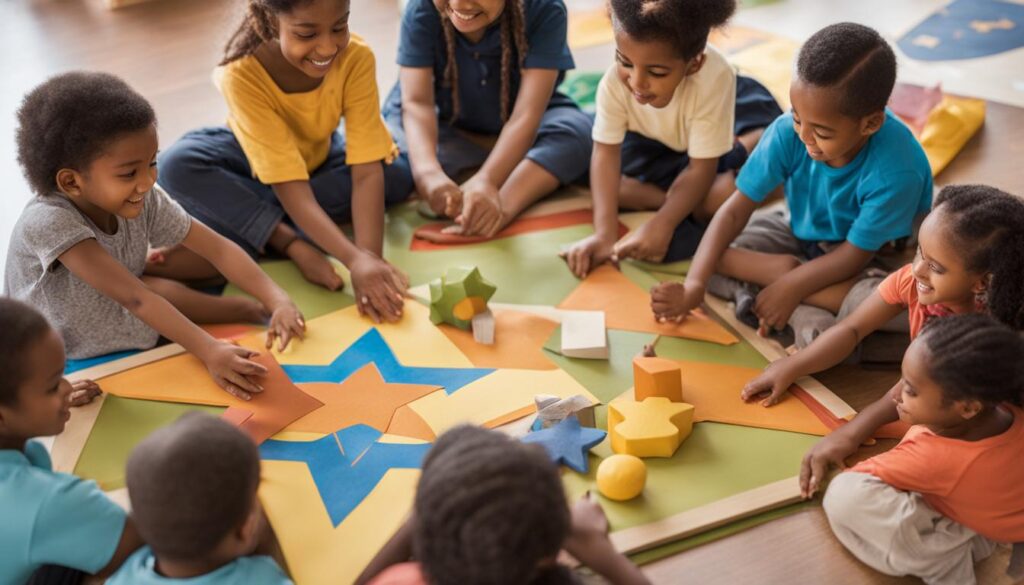
In conclusion, addressing religious diversity in schools is vital for creating inclusive environments, respecting beliefs, promoting tolerance, and accommodating religious practices. By providing designated prayer rooms, incorporating religious education, and organizing multicultural events, educational institutions can foster an inclusive atmosphere where students can learn, grow, and develop an appreciation for diversity.
Constitutional Rights and Prayer in School
When discussing prayer in schools, it is essential to consider the constitutional rights and legal frameworks that shape this debate. The United States Constitution guarantees freedom of religion and the separation of church and state, both of which play a crucial role in determining the boundaries of prayer in educational settings.
The First Amendment of the Constitution begins with the establishment clause, which prohibits the government from establishing a religion or favoring one over others. This clause serves as the foundation for maintaining religious neutrality in public schools. Additionally, the First Amendment’s free exercise clause ensures the right of individuals to freely practice their religion, without undue interference or coercion.
Over the years, the Supreme Court has rendered various landmark decisions on prayer in schools, further clarifying the constitutional boundaries. In the 1962 case of Engel v. Vitale, the Court ruled that public schools cannot sponsor or endorse prayer, as it violates the establishment clause. Similarly, in the 2000 case of Santa Fe Independent School District v. Doe, the Court held that student-led, school-sponsored prayers at public school events, such as football games, are unconstitutional.
| Key Supreme Court Decisions on Prayer in Schools | Year |
|---|---|
| Engel v. Vitale | 1962 |
| Santa Fe Independent School District v. Doe | 2000 |
| Lee v. Weisman | 1992 |
| Marsh v. Chambers | 1983 |
“The Supreme Court has consistently held that public schools must remain neutral in matters of religion in order to protect individuals’ freedom of conscience and maintain an inclusive educational environment.”
It is crucial for schools to navigate these constitutional rights to ensure the promotion of religious freedom and the avoidance of any form of religious coercion or favoritism. By respecting the boundaries set by the First Amendment, schools can foster an inclusive and diverse educational environment that respects students’ individual beliefs.
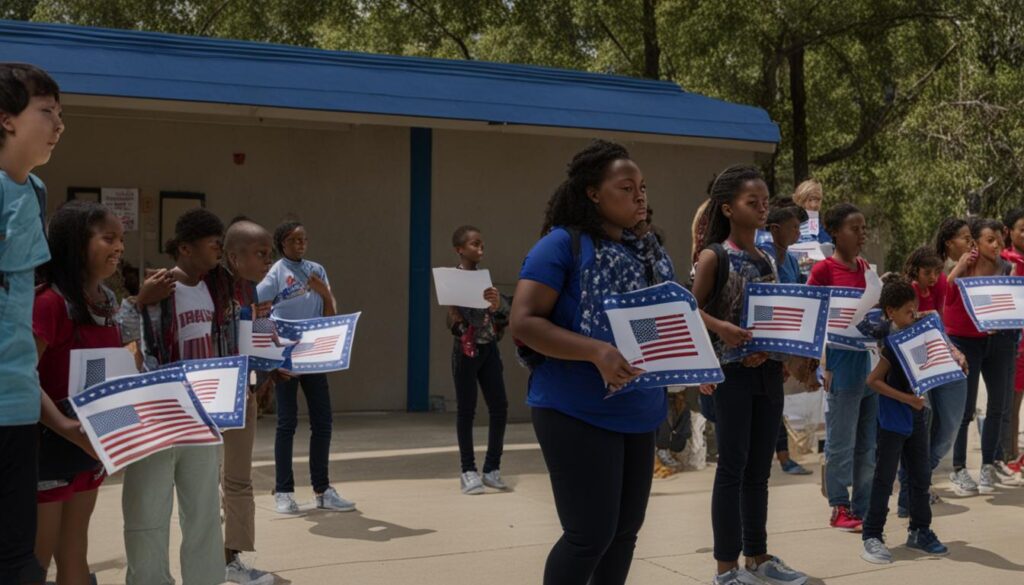
Additional Resources:
- Cornell Law School: Establishment Clause
- Cornell Law School: First Amendment
- PBS NewsHour: School Prayer – What Are the Laws?
Conflicts and Controversies: Religion in School
Religion in schools has always been a topic of controversy, stirring debates among parents, educators, and policymakers. One of the main controversies surrounding religion in schools is the concern that it may exclude or impose specific values on students.
Many parents worry that the presence of religion in schools may infringe upon their own beliefs or impose a particular set of values on their children. On the other hand, some argue that excluding religion from schools may hinder students’ understanding of different cultures and limit their exposure to diverse beliefs.
The accommodation of religious expression is another area of contention. Some argue that allowing religious practices in schools, such as prayer or wearing religious clothing, promotes freedom of religion and expression. Others argue that such practices may lead to discrimination or create an uncomfortable environment for students who do not share the same beliefs.
Parental Concerns
Parents play a significant role in shaping the debate surrounding religion in schools. They express concerns about the potential influence of religious teachings on their children and worry that schools may not adequately address the diversity of beliefs present in the student body.
“I want my child to receive a well-rounded education that values diversity and promotes critical thinking,” says Maria Thompson, a concerned parent. “I worry that if religious teachings are incorporated into the curriculum, it may overshadow other important subjects and limit my child’s exposure to different perspectives.”
Efforts to exclude religion from schools are often driven by concerns over the separation of church and state. This principle, rooted in the First Amendment, aims to ensure that public institutions, including schools, do not favor or endorse any specific religious belief.
In conclusion, the controversies surrounding religion in school highlight the complexity of accommodating diverse beliefs while ensuring a non-discriminatory and inclusive educational environment. Balancing the rights of students to express their religious beliefs with the need for neutrality and respect for all is a delicate task that requires open dialogue and a commitment to fostering understanding and inclusivity.
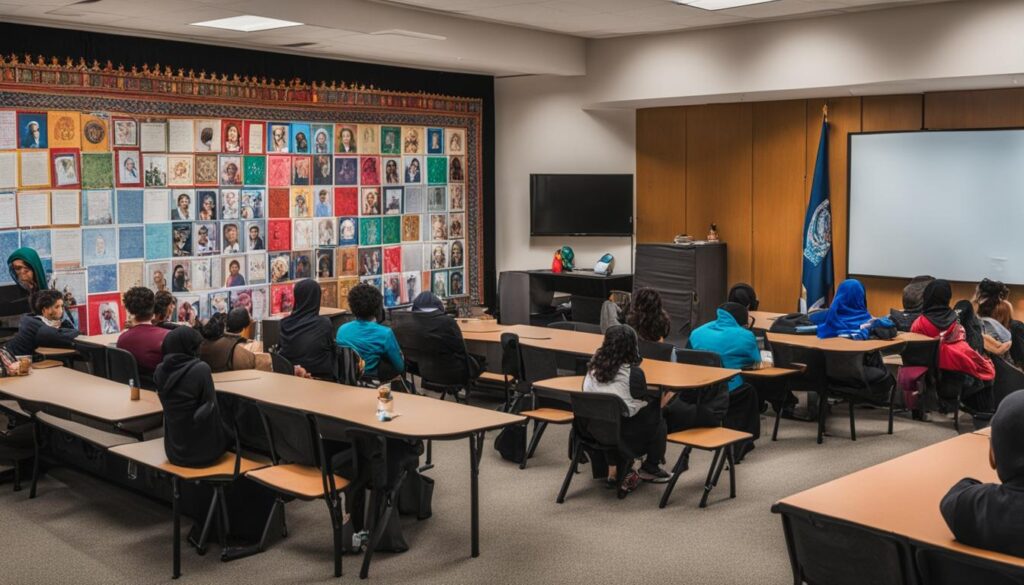
The Importance of Open Discussion
Open discussion plays a crucial role in fostering mutual respect, tolerance, and inclusivity within schools. By providing safe spaces for dialogue, students are encouraged to share their thoughts, beliefs, and experiences, leading to a deeper understanding of different perspectives.
“Open dialogue allows students to challenge stereotypes and misconceptions, promoting empathy and respect for diverse cultures and religions,” says Dr. Sarah Thompson, a renowned expert in educational psychology. “It creates an environment where students can learn from one another and develop critical thinking skills.”
Fostering Mutual Respect
Engaging in open discussions about religion helps students develop a sense of mutual respect. Through active listening and thoughtful responses, students learn to appreciate the richness and complexity of different religious beliefs and practices. This fosters an environment of understanding, where individuals can coexist and embrace diversity.
Promoting Tolerance
Open dialogue also promotes tolerance by allowing students to challenge their own biases and assumptions. It encourages them to step outside their comfort zones and engage with ideas and perspectives that may differ from their own. This process of reflection and exploration helps build bridges of understanding and acceptance.
Safe Spaces for Dialogue
Creating safe spaces for dialogue is essential in ensuring that all students feel comfortable expressing their views without fear of judgment or discrimination. These spaces can take the form of classroom discussions, multicultural clubs, or designated events focused on promoting interfaith dialogue and understanding.
By fostering open discussion, schools can cultivate an inclusive and respectful environment where students can learn from one another, develop empathy, and celebrate the richness of religious diversity.
| Benefits of Open Discussion | Keywords |
|---|---|
| Promotes mutual respect | Mutual respect |
| Fosters tolerance | Promoting tolerance |
| Encourages critical thinking | Critical thinking skills |
| Builds bridges of understanding | Tolerance |
| Cultivates an inclusive environment | Safe spaces for dialogue |
Education’s Role in Shaping Perspectives
The role of education in shaping students’ perspectives on prayer in schools is crucial. By incorporating comparative religious studies and promoting interfaith dialogue, educational institutions can foster empathy, respect, and a deeper understanding of religious diversity. These initiatives enable students to develop a comprehensive knowledge of different belief systems, facilitating conversations that challenge preconceived notions and promote inclusivity.
Comparative religious studies provide students with the opportunity to explore various religions, their core beliefs, rituals, and practices. This academic approach encourages critical thinking and analysis, promoting a broader perspective and dispelling misconceptions about different faiths. Through these studies, students can gain a better understanding of their own beliefs and develop a more empathetic outlook towards others.
“Education is the most powerful weapon which you can use to change the world.” – Nelson Mandela
In addition to comparative religious studies, interfaith dialogue plays a crucial role in shaping perspectives. By providing a platform for open and respectful discussions, students can engage in meaningful conversations about various religious practices, traditions, and values. This dialogue cultivates mutual respect, fosters empathy, and encourages collaboration among students of different faiths. It promotes a sense of unity and inclusivity within educational environments.
Benefits of Incorporating Comparative Religious Studies and Interfaith Dialogue:
- Fosters empathy and respect among students
- Promotes a deeper understanding of religious diversity
- Dispels misconceptions and stereotypes
- Encourages critical thinking and analysis
- Fosters collaboration and unity
Table: Comparing the Impact of Comparative Religious Studies and Religious Dialogue
| Aspect | Comparative Religious Studies | Religious Dialogue |
|---|---|---|
| Promotes Understanding | Provides knowledge of different religions | Encourages conversations about religious practices and beliefs |
| Fosters Empathy | Challenges preconceived notions and stereotypes | Cultivates mutual respect and understanding |
| Encourages Critical Thinking | Promotes analysis and evaluation of religious concepts | Challenges assumptions and encourages open-mindedness |
| Creates Inclusive Environments | Provides a comprehensive understanding of religious diversity | Fosters collaboration and unity among students of diverse faiths |
Examples of Accommodating Religious Diversity
Creating inclusive environments in schools involves implementing strategies that accommodate religious diversity and promote understanding among students. Here are some examples of effective practices:
Religious Diversity Clubs
Establishing religious diversity clubs in schools can provide students with a platform to learn about various religions, celebrate cultural traditions, and engage in respectful discussions. These clubs can organize events, guest speakers, and educational activities that foster an appreciation for religious diversity.
Guest Speakers
Inviting guest speakers from different religious backgrounds to share their experiences and beliefs can enhance students’ understanding and promote dialogue. These speakers can offer unique insights into various faiths, debunk stereotypes, and encourage students to embrace diversity.
Multicultural Events
Organizing multicultural events that showcase different religious practices and traditions can help create a sense of unity and mutual respect within the school community. These events can include performances, exhibitions, and interactive activities that allow students to explore and appreciate the richness of different religions.
Incorporating these practices into the educational environment can foster inclusivity, promote understanding, and create a supportive atmosphere for students of all religious backgrounds. By providing opportunities for dialogue and celebration, schools can actively contribute to the development of respectful and informed global citizens.
Conclusion
In conclusion, the debate over whether schools should have prayer rooms requires careful consideration of the pros and cons. The exploration of teenagers’ views on prayer in public schools reveals the importance of fostering dialogue and understanding among students with diverse beliefs. While prayer in education can provide emotional support, foster a sense of community, and promote spiritual growth, it is crucial to address religious diversity in schools and create inclusive environments that respect the beliefs of all students.
The constitutional rights surrounding prayer in school, as established by the First Amendment, underscore the need for balance and sensitivity in accommodating religious expression. Conflicts and controversies surrounding religion in schools highlight the challenge of finding a middle ground that avoids excluding or imposing values on students while maintaining a non-discriminatory and inclusive educational environment.
Open discussion plays a significant role in promoting mutual respect, tolerance, and inclusivity. By incorporating comparative religious studies and encouraging interfaith dialogue, education can shape students’ perspectives, fostering empathy, and respect for religious diversity. Accommodating religious diversity can be achieved through initiatives such as religious diversity clubs, inviting guest speakers, and organizing multicultural events that showcase different religious traditions.
In weighing the pros and cons, it is clear that fostering dialogue and understanding, while upholding religious freedom and inclusivity, are of utmost importance in creating inclusive school environments. By embracing these principles, schools can provide a space where students with diverse beliefs feel respected and valued, ultimately contributing to a more harmonious and inclusive educational experience.
FAQ
Should schools have prayer rooms?
The decision to have prayer rooms in schools is a matter of ongoing debate. Some argue that prayer rooms can provide emotional support, foster a sense of community, and promote spiritual growth among students. Others believe that public schools should remain secular and not include any religious practices.
What do teenagers think about prayer in public schools?
Teenagers’ views on prayer in public schools vary. According to a survey conducted among high school students, some teenagers believe that prayer rooms can be beneficial in supporting students’ spiritual needs and fostering religious tolerance. However, others feel that prayer should remain a private practice outside of the school setting.
What are the benefits of prayer in education?
Prayer in education can provide emotional support to students, foster a sense of community, and promote spiritual growth. Studies suggest that prayer can positively impact students’ well-being, resilience, and moral development by providing a source of comfort and guidance.
How can schools address religious diversity?
Schools can create inclusive environments by respecting the beliefs of all students. Strategies may include providing designated prayer rooms or periods of silence, incorporating education on different religions, and promoting understanding and tolerance among students.
What are the constitutional rights surrounding prayer in school?
The First Amendment of the United States Constitution applies to the debate over prayer in public schools. The establishment clause prohibits the government from endorsing or promoting a particular religion, while the free exercise clause protects individuals’ right to practice their chosen religion. Supreme Court rulings have shaped the boundaries of prayer in educational settings.
What are the conflicts and controversies surrounding religion in schools?
There are ongoing debates and conflicts surrounding religion in schools. Some individuals express concerns about religion being either excluded or imposed upon students. Finding a balance between accommodating religious expression and ensuring an inclusive educational environment is a challenge that needs to be addressed.
Why is open discussion about religion in schools important?
Open discussions about religion in schools can promote mutual respect, understanding, and tolerance among students. Providing safe spaces for dialogue allows students to voice their thoughts and concerns, fostering a more inclusive and accepting school environment.
What role does education play in shaping students’ perspectives on prayer in schools?
Education plays a crucial role in shaping students’ perspectives on prayer in schools. Incorporating comparative religious studies and promoting interfaith dialogue can foster empathy, respect, and a deeper appreciation for religious diversity among students.
How can schools accommodate religious diversity effectively?
Schools can accommodate religious diversity by creating inclusive environments. This can be achieved through the establishment of religious diversity clubs, the inclusion of resources and materials representing various religions, inviting guest speakers from different faiths, and organizing multicultural events to showcase different religious practices and traditions.
Source Links
- https://jesusprayerministry.com/why-prayer-should-be-allowed-in-school/
- https://www.nytimes.com/2022/05/19/learning/what-students-are-saying-about-prayer-in-schools-quelling-self-doubt-and-a-field-in-starlight.html
- https://www.pewresearch.org/religion/2019/10/03/religion-in-the-public-schools-2019-update/


